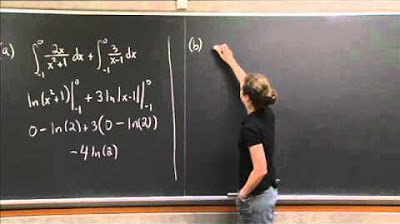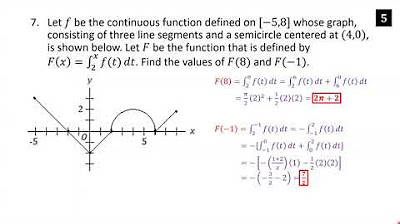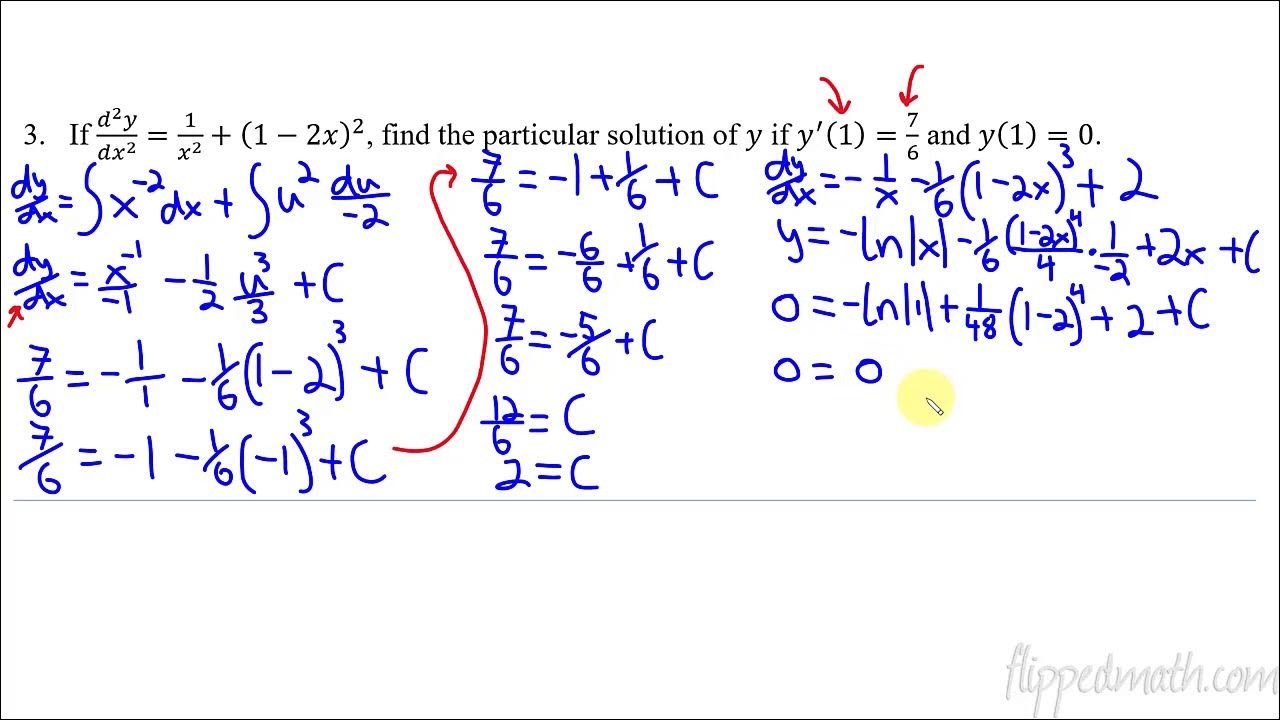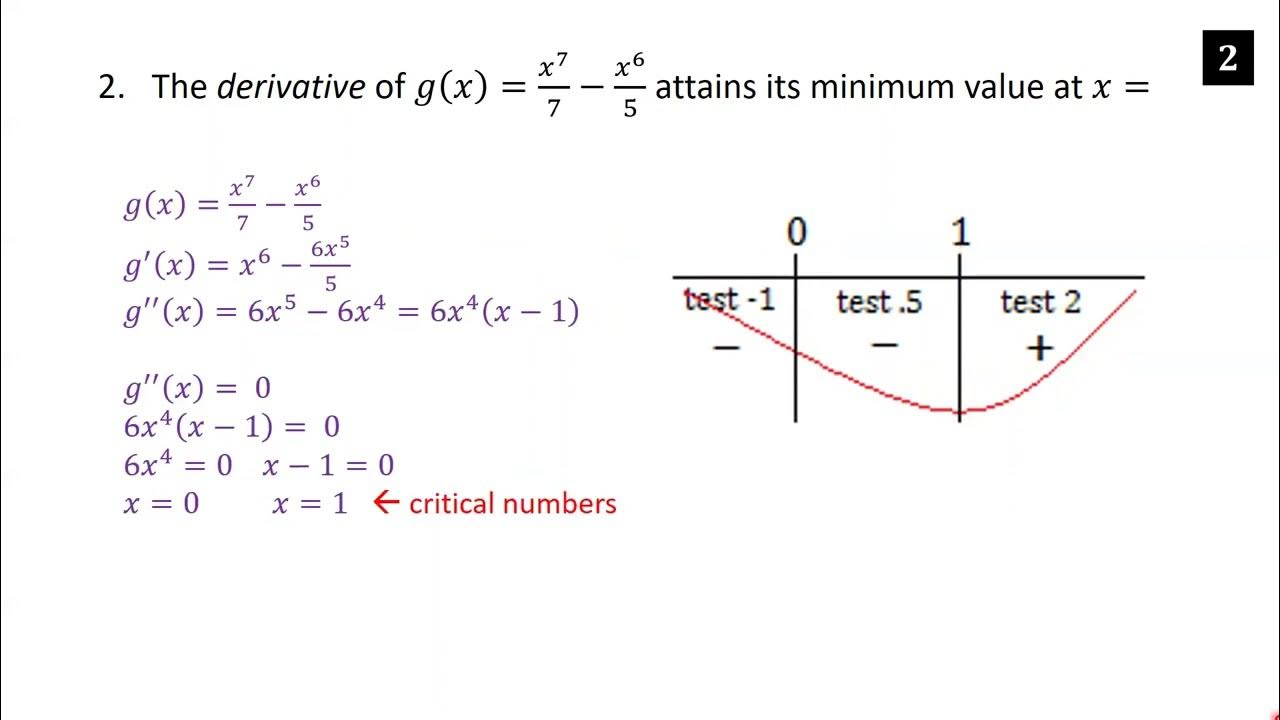AP Calculus AB Crash Course Day 2 - Integration
TLDRThe video script delves into advanced calculus concepts, focusing on integrals and differential equations. It begins with a complex integral involving various power functions and roots, which is simplified using power rules and logarithmic properties. The script then tackles the integral of tangent squared, employing trigonometric identities and substitution methods to find the antiderivative. A substitution technique is also used to solve an integral involving a cubic root and squared function. The area under a curve, bounded by specific functions and axes, is calculated to demonstrate integral applications in geometry. The midpoint sum method is applied to approximate the average value of a function over an interval, using given data points. The script concludes with solving a differential equation using separation of variables and substitution, finding a particular solution that satisfies a given initial condition. Throughout, the video emphasizes the importance of understanding the underlying mathematical principles and the application of various calculus techniques.
Takeaways
- 📚 **Integral Simplification**: The script begins by simplifying an integral expression using power rules, which is a fundamental approach in calculus to make integration easier.
- 🔍 **Special Cases in Integration**: It highlights the special case of 1/x, which integrates to the natural logarithm of the absolute value of x, a key concept in integral calculus.
- 🌱 **Roots and Exponents**: The script demonstrates the conversion of roots to exponents in integral expressions, which is crucial for applying the power rule to such terms.
- 📈 **Antiderivatives and Constants**: It emphasizes the importance of adding the arbitrary constant 'C' when finding antiderivatives, indicating the general form of an indefinite integral.
- 🧮 **Complex Fractions**: The process of simplifying complex fractions that result from integration is shown, which is an essential skill for exact integration results.
- 🔁 **Pythagorean Identity**: The script uses the Pythagorean identity involving tangent and secant squared to transform a non-elementary integral into a solvable form.
- 🏗️ **Substitution Method**: It showcases the use of substitution in integrals, a common technique for simplifying and solving complex integrals, with specific examples provided.
- 📐 **Definite Integrals and Geometry**: The script connects definite integrals with geometric concepts, such as finding the area under a curve, which is a common application in calculus.
- 🚀 **Midpoint Sum Approximation**: It introduces the concept of midpoint sum for approximating definite integrals, which is a numerical method useful when analytical solutions are difficult to obtain.
- ⛽ **Real-World Application**: The script applies integration to a real-world problem involving the flow of gasoline into a bucket, demonstrating the practical use of calculus.
- 🔧 **Differential Equations**: The solution to a differential equation is found using separation of variables, a common method for solving first-order differential equations.
Q & A
What is the first step in rewriting the integral expression for easier integration?
-The first step is to rewrite the expression using power rules, which involves changing the denominators to have negative exponents, such as turning 1/x^2 to x^(-2).
How does the integral of 1/x simplify when using power rules?
-The integral of 1/x simplifies to the natural logarithm of the absolute value of x, as 1/x is the derivative of ln|x|.
What substitution is used to transform the integral of tan^2(3x)?
-The Pythagorean identity involving tan^2(x) and sec^2(x) is used, where tan^2(x) = sec^2(x) - 1, and then x is replaced by 3x.
How is the integral of 3x^2/sqrt(8 - x^3) approached?
-A substitution method is used, where u = 8 - x^3, and the derivative du is related to dx by du = -3x^2 dx.
What is the geometric interpretation of the integral of x^2 * sqrt(1 - x^3) from 0 to 1?
-The integral represents the area of the region in the first quadrant bounded by the graph of y = x^2 * sqrt(1 - x^3), the line x = 1, and the x-axis.
How is the midpoint sum approximation used to estimate the integral of g(t) from 0 to 4?
-The midpoint sum approximation is used by dividing the interval [0, 4] into two sub-intervals of equal length, using the midpoint of each sub-interval (1 and 3), and summing the product of the function value at the midpoint and the width of the sub-interval.
What does the term 'one-fourth integral from 0 to 4 of g(t) dt' represent in the context of the gasoline problem?
-It represents the average amount of gasoline in the bucket in pints over the time interval from 0 to 4 minutes.
How is the differential equation dy/dx = e^(y-1) * (2x^3 - 5) solved for a particular solution y = f(x) that passes through the point (1,1)?
-The equation is separated into two parts, integrated, and then solved for y. The arbitrary constant is determined by substituting the point (1,1) into the equation, and the final solution is expressed in terms of x.
What is the method used to compute the function G(x) = the integral from 0 to x of g(t) dt?
-The method involves integrating g(t) with respect to t from 0 to x, which results in an antiderivative of g(t) evaluated from 0 to x.
How is the value of G(-5) computed?
-Since the interval is negative, the integral is computed from -5 to 0 and the result is negated. The area under the curve from -5 to 0 is computed as a trapezoid with bases 1 and 3 and height 5, resulting in a value of -10.
What is the final result of the computation G(-5) + G(4) / (G(10) - G(7))?
-The final result is computed by substituting the computed values of G(-5), G(4), G(10), and G(7) into the expression, which simplifies to -12/9 or -4/3.
Outlines
🧮 Integral Calculation and Power Rule Application
This paragraph discusses the process of rewriting an integral expression for easier integration using power rules. It covers the conversion of terms with roots and fractions into exponents and the subsequent integration of each term. The paragraph also includes the simplification of complex fractions and the application of the power rule to find anti-derivatives. An example integral from 0 to π/12 of tan^2(3x) is solved using trigonometric identities and substitution.
📐 Substitution and Definite Integrals in Geometry
The second paragraph deals with the application of substitution in solving definite integrals. It covers the solution of an integral involving x^2/√(8-x^3) from 0 to 2 by substituting u = 8 - x^3. The limits of integration are adjusted accordingly, and the integral is solved using the power rule. The paragraph also calculates the area of a region in the first quadrant bounded by a curve, a line, and the x-axis by setting up an integral and using substitution to solve it.
🛒 Midpoint Sum Approximation and Differential Equations
This paragraph begins with approximating the integral of a function g(t) from 0 to 4 using a midpoint sum with two sub-intervals. The average amount of gasoline in a bucket over 4 minutes is calculated using the midpoint sum method. The paragraph then shifts to solving a differential equation dy/dx = e^(y-1) * (2x^3 - 5). A particular solution y = f(x) that passes through a specific point is found by separating variables and integrating. The solution is simplified and expressed in terms of y.
📈 Definite Integrals and Area Calculations
The fourth paragraph focuses on computing definite integrals and areas. It calculates the integral of a function g(x) from -5 to 0 and from 0 to 4, interpreting these as areas under a curve. The integral from 7 to 10 is split into two parts to account for the positive and negative areas under the curve. The paragraph also calculates the value of an integral function G(x) = ∫(g(t) dt) from 0 to x for various limits, involving the computation of areas under different line segments of the curve g.
🔢 Numerical Integration and Area Computation
The final paragraph provides a numerical approach to computing definite integrals. It calculates the value of G(-5) by integrating g(x) from -5 to 0 and adjusting for the direction of integration. The areas under the curve g for intervals [0, 4], [7, 10] are computed by breaking them into simpler shapes like rectangles and triangles. The final computation involves plugging in the calculated areas and performing arithmetic operations to find the desired integral value.
Mindmap
Keywords
💡Integral
💡Power Rule
💡Logarithm
💡Substitution
💡Midpoint Sum
💡Differential Equation
💡Separation of Variables
💡Antiderivatives
💡Trapezoidal Rule
💡Average Value
💡Definite Integral
Highlights
Rewriting the expression inside the integral using power rules makes it easier to integrate.
1/x^2 can be rewritten as x^(-2) to simplify the expression.
1/x becomes a logarithm when integrated.
The cube root of x can be rewritten as x^(1/3) in the denominator.
Integrating using the power rule involves adding 1 to the exponent and dividing by that number.
Simplifying complex fractions by multiplying by the reciprocal can make expressions easier to work with.
There is no elementary antiderivative for tan^2(x) without some manipulation.
The Pythagorean identity tan^2(x) + 1 = sec^2(x) can be used to rewrite tan^2(3x).
Substitution can simplify integrals involving secant squared.
The antiderivative of sec^2(x) is tan(x), which can be used after substitution.
Definite integrals can be evaluated by plugging in the limits of integration.
Substitution is a powerful technique for evaluating integrals, especially when the integrand is a radical expression.
When using substitution, it's important to change the limits of integration appropriately.
The area under a curve between two points can be found by integrating the function over that interval.
A midpoint sum approximation can be used to estimate a definite integral by breaking the interval into subintervals.
The average value of a function over an interval can be found by multiplying the definite integral by 1/(b-a).
Separation of variables is a useful technique for solving certain differential equations.
Substitution can simplify the process of solving differential equations.
An initial condition can be used to find the constant of integration in a particular solution to a differential equation.
Definite integrals can be used to find areas under a curve, which can represent physical quantities like the amount of gasoline in a bucket.
Transcripts
Browse More Related Video

AP Calculus AB Crash Course Day 5 - Integration and Differential Equations

Integration Practice I | MIT 18.01SC Single Variable Calculus, Fall 2010

AP Calculus AB Crash Course Day 8 - Integration and Riemann Sums

Definite Integrals!

Calculus AB/BC – 7.2 Verifying Solutions for Differential Equations

AP Calculus AB Crash Course Day 7 - Differentiation, Related Rates, and the Mean Value Theorem
5.0 / 5 (0 votes)
Thanks for rating: